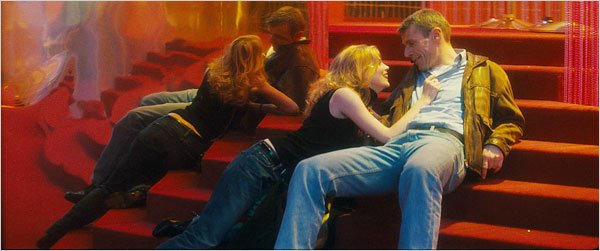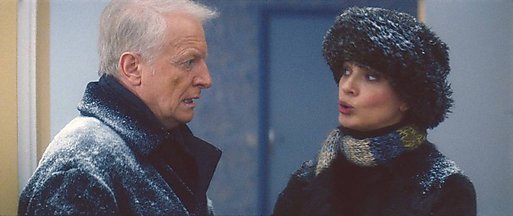From the Chicago Reader (June 8, 2007) — J.R.
PRIVATE FEARS IN PUBLIC PLACES ****
DIRECTED BY ALAIN RESNAIS | WRITTEN BY JEAN-MICHEL RIBES AND ALAN AYCKBOURN
WITH SABINE AZEMA, ISABELLE CARRE, LAURA MORANTE, PIERRE ARDITI, ANDRE DUSSOLLIER, AND LAMBERT WILSON
It might sound crazy to call Alain Resnais the last of the great Hollywood studio directors when he’s never made a single movie in Hollywood. But classic Hollywood filmmaking, as defined by the aesthetics and craftsmanship of the system from the 30s through the 60s, transcends location. Indeed, many of the best recent examples, like Black Book and Angel-A, are European. And from its breathtaking opening shot, which sweeps across a wintry Parisian cityscape to the windows of an apartment house just as blinds are lowered and a door slams, the director’s newest film, Private Fears in Public Places, clearly belongs to that tradition.
Made by Resnais in his mid-80s, this movie is a real heart-breaker—one reason I prefer the French title, Coeurs (“hearts”). Derived from a recent play by Alan Ayckbourn (Resnais also adapted his Intimate Exchanges for the 1993 film Smoking/No Smoking), Private Fears in Public Places is a labyrinthine tale of crisscrossing destinies, missed connections, enclosures that poignantly echo one another, and muffled romantic and erotic feelings. The six main characters are so boxed in, bad fits in cramped spaces, that no one ever seems to get it on. The only two who are romantically involved, a discharged soldier who drinks named Dan (Lambert Wilson) and his fiancee, Nicole (Laura Morante), are becoming estranged. Thierry (Andre Dussollier), the real-estate broker trying to find them a flat, is a bachelor living with his kid sister, Ga’lle (Isabelle Carre), who responds in vain to personal ads. Thierry harbors a secret crush on his assistant, Charlotte (Sabine Azema), a devout Christian who spends her evenings caring for a sick and abusive old man (only heard offscreen and played by Claude Rich). The old man’s widower son, Lionel (Pierre Arditi), works as a bartender at a hotel that Dan checks into after he and Nicole agree to a trial separation. Charlotte, meanwhile, lends Thierry tapes of her favorite inspirational TV show, but has forgotten to erase her own privately recorded erotic dances, while Ga’lle responds to an ad placed by Dan, who takes her to Lionel’s bar….
It’s an archetypal and at points almost insufferably clever piece of boulevard theater–the sort of thing Resnais has been producing periodically ever since he adapted the French play Melo in 1986 and began mining his childhood playgoing experiences. At the same time, it’s a lyrical lament that doubles as a comprehensive retrospective of his career. The characters, invested with an almost tragic tenderness, are by and large played by actors Resnais has been using for two decades. When Dan and Ga’lle trade confidences in the hotel bar, we could almost be back in Hiroshima Mon Amour (1959), just as a camera movement exploring part of a flat summons up Last Year at Marienbad (1961) and a montage of domestic objects returns us to Muriel (1963). All three of these films, to some degree, are about private fears in public places, a theme that’s come up again and again in his work.
I’ve interviewed Resnais twice, in the mid-70s and the early 80s, and both times his painful shyness was immediately apparent. Since then it’s apparently become even more acute: for a French DVD box set of five of his features, he agreed only to an audio interview. It’s an affliction shared by everyone in Private Fears. Resnais’ emotional intensity as an artist seems to depend on turning other people’s material into his own. “He always hides behind his writers,” filmmaker Claire Denis said to me after the premiere of Coeurs at the Venice film festival last August. I’d add that he hides behind his composers, too: he’s commissioned two of his best film scores from Steven Sondheim (Stavisky . . . ) and Miklos Rosza (Providence) and solicited the yearning score for Private Fears from Mark Snow, who wrote music for The X-Files.
This is only the third time Resnais has shot in ‘Scope, after his two most abstract and formally dazzling works, Le Chant du Styrene (an inspired industrial short of 1958) and Last Year at Marienbad. The conventional wisdom about abstraction and formalism says they’re cold and emotionless, and Resnais has often been described in those terms, but these two films are nothing if not emotionally charged in conveying jubilation and romantic longing, respectively. Private Fears in Public Places, which deals with the continuing ravages of Victorian repression on contemporary life, is about the intensity of buried emotions. So why, then, is it in ‘Scope? Maybe because the material is so claustrophobic—the breadth of the images gives the confinement an epic sweep.
For Resnais, confinement has always been primarily a mental state, and the imaginations of his characters seem closely tied to their freedom. It’s also a matter of culture and ideology. His features can be divided into two groups, those that deal with France’s relative isolation and those predicated on its compatibility with the rest of the world: Hiroshima Mon Amour (Japan), Last Year at Marienbad (set in eastern Europe with an Italian actor), La Guerre Est Finie (Spain), Je T’aime, Je T’aime (Belgium), Stavisky . . . (Russians in France), Providence (the U.S.), Gershwin (New York), and now Private Fears in Public Places, a French story derived from an English play. Smoking/No Smoking, Resnais’ first adaptation of an Ayckbourn play, is set in Yorkshire, presenting a skewed French perception of the English that makes it for me the least inviting of his films. For Private Fears in Public Places, however, screenwriter Jean-Michel Ribes has translated the play into French so persuasively that the seemingly antithetical traits of both cultures are fused.
Resnais has cited American comic strips and French serials, along with Alfred Hitchcock and Ernst Lubitsch, as major influences, and traces of this are plainly visible in his work. Less an intellectual than either Godard or Rivette—though more consistently a leftist than either—he’s in some ways a more passionate connoisseur of pop culture. The artificial-looking settings in Private Fears in Public Places—the flats, bars, and offices, even the streets we see outside them—are tied to his encyclopedic knowledge of studio filmmaking, Hollywood in particular, and are inseparable from his poetics. The film’s constant snowfall, not at all indicative of typical Paris weather, is a personal invention with no counterpart in the play. (Another is the 19th-century portraits and landscape paintings, by Turner and others, that crop up in some of the flats, pointing toward the characters’ unacknowledged Victorianism.) This magical heavy snow, viewed through windows and used in transitions bridging the film’s 54 short scenes, is as laden with metaphorical nuance as the snow in Citizen Kane and The Magnificent Ambersons. It’s so central to the overall mood and visual texture that when we suddenly see it falling inside a kitchen during a climactic scene, shortly before the camera starts to encircle two characters, the moment’s emotional logic is perfectly pitched. Fundamentally, Resnais has always been an expressionist, using his settings and compositions to evoke the inner states of his characters. Here, tying expressionism to social critique, he becomes an improbable but unmistakable blood brother of Carl Dreyer, turning material written by others into a highly personal testament that burns its way into our souls.


